Application 1: Recruitment and Selection
Using AI to sort CVs and select candidates
Artificial intelligence (AI) is revolutionizing the recruitment process by automating many tasks.
First, AI tools can be used to draft job descriptions and distribute job offers on the relevant platforms.
Next, AI-enabled applicant tracking systems (ATS) filter resumes to identify the most qualified candidates and automate initial communications.
Predictive analysis tools assess candidates’ skills and aptitudes, predicting their suitability for the position and even their likelihood of success within the company. Sophisticated matching systems compare candidate profiles with those of successful employees to identify the best matches. This significantly reduces the time and effort needed to shortlist suitable candidates.
Other tools can be used to conduct initial video interviews, to assess candidates’ linguistic and non-verbal skills, and to communicate the next steps in the recruitment process.
Examples of tools and technologies
There’s no shortage of tools and platforms in the sector. Dozens of companies have sprung up offering tools based on artificial intelligence.
- For sourcing, we can mention
Manatal
,
CVVIZ
,
Hireez
- For the first video interviews and conversation with candidates :
HireVue
,
Pymetrics
- For ATS integrating AI functionalities :
Greenhouse
,
Lever
, or even
SmartRecruiters
Most tools combine several functions, in several languages, and can therefore be used at all stages of the recruitment process. What’s more, these tools generally integrate with existing ATSs. The choice of tools to implement will therefore depend on your needs and your current technological base, so that you can select those that can be easily plugged into your existing tools.
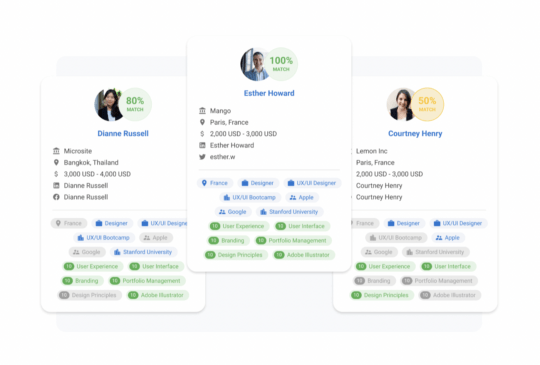
Manatal matching application
Benefits and impact on the recruitment process
The primary aim of using artificial intelligence in recruitment is to reduce time-consuming and redundant tasks as much as possible, so that your teams can spend their time on what adds the most value.
AI acts as a first filter, validating candidates’ technical skills as well as their soft skills. So, thanks to AI, HR can focus on the human and the candidate’s “fit” with the team and the company.
Beware, however, of the risk of bias. AI algorithms can reproduce and amplify the biases present in training data. It is crucial to monitor and adjust models to ensure equity and inclusiveness.
Application 2: Training and Development
Personalizing training paths with AI
Thanks to AI, training programs can be tailored to employees’ individual needs. Adaptive learning systems can propose specific training content based on employees’ current skills and career objectives, thus increasing the effectiveness of training (adaptive learning).
Combined with virtual reality, training courses can even become immersive, staging complex scenarios to develop soft skills such as leadership and conflict resolution.
AI-enabled training platforms and software
All LMS (Learning Management System) solutions, such as 360 Learning or Coursera, now include AI functionalities. both to facilitate the creation of training content for companies and to suggest training paths based on learners’ interests and skills to be developed.
The platform
TeachUp
platform, for example, enables training content to be adapted in real time to the learner’s level.
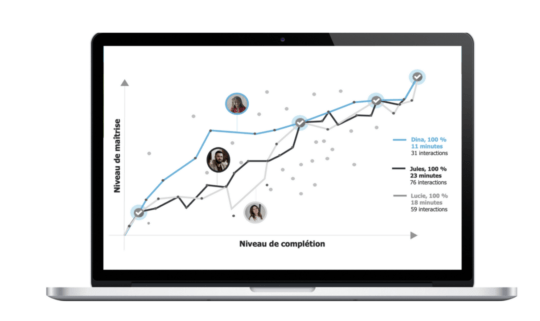
TeachUp graph showing learners’ level of proficiency
Benefits for employees and the organization
Thanks to the contribution of artificial intelligence, training courses take on a new dimension for learners. By being more immersive and personalized, these AI-integrated training courses promote memorization and behavioral anchoring. The result on the learner should therefore be better. In this respect, the platforms and software used can also provide personalized summaries of knowledge acquired or to be developed, enabling the essential to be retained and returned to as and when required.
Application 3: Performance Management
Evaluating and monitoring employee performance with AI
Traditionally, performance appraisal is based on annual interviews and subjective opinions. AI can transform this process by making it continuous and data-driven.
Indeed, AI can collect data from a variety of sources, such as task management systems, peer feedback, project results, and even interactions on internal communication platforms. By analyzing this data in real time, AI tools can provide detailed reports on individual and team performance, identifying trends and areas requiring improvement.
Analysis and feedback tools
AI systems can also provide real-time feedback, letting employees know immediately how they’re doing and where they can improve.
15Five for example, provides SMEs with a real-time view of the achievement of individual and collective objectives. Managers can then take appropriate action to reduce the gap between expected and actual.
Other tools such as
Lattice
or
Reflektiv
also help optimize employee performance by transforming employee data into actions.
This continuous approach allows us to correct trajectories and support skills development along the way, rather than waiting until the end of the year for annual reviews.
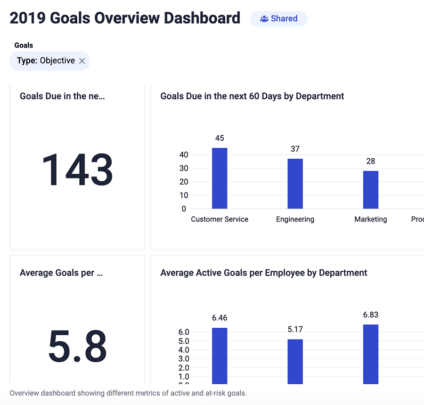
Reflektiv example
Benefits for continuous improvement and productivity
One of the main advantages of AI is its ability to reduce human bias in performance evaluation. AI algorithms assess performance based on predefined criteria and objective data, providing fairer and more equitable evaluations. In this way, an employee can be assessed on the basis of productivity, quality of work and adherence to deadlines, rather than subjective impressions from his or her manager.
Using predictive analytics, AI can identify gaps in employees’ skills and recommend customized development plans. These plans can include suggestions for specific training courses, workshops, or particular projects that will help employees improve their skills and progress in their careers.
Application 4: Talent management and workforce planning
Forecasting skills requirements and proactive talent management
AI algorithms can help optimize human resources planning by predicting future workforce requirements and adjusting staffing accordingly. This makes it easier to manage peaks in activity and absences, as well as other internal and external factors that can have an impact on staff, ensuring that the company always has the skills it needs to run smoothly.
AI-based workforce planning software and platforms are developing along these lines. For example:
- The platform
Airudi
platform, which enables proactive planning of human resources based on past and current data, optimizing schedules in real time according to weather conditions, for example. - The software
Reflex
software, which promises to reduce personnel costs and improve sales performance by forecasting supply chain workloads.
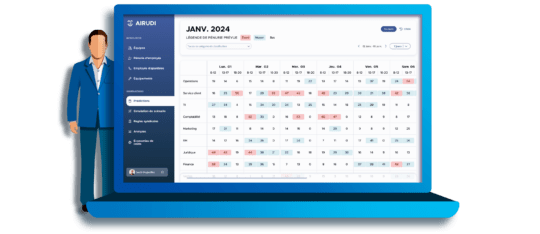
Airudi software shows risk of labor shortages
Impact on HR strategy and talent management
Thanks to software and platforms that integrate artificial intelligence into workforce planning, HR teams can save time. No more excel files full of formulas that have to be constantly revised to adapt to day-to-day constraints (absences, delays, exceptional events…). AI enables more agile, precise and efficient planning. Optimizing planning with AI maximizes resource utilization and therefore minimizes costs.
Application 5: Employee engagement and well-being
Monitoring and improving employee engagement via AI
AI can analyze internal communications and employee interactions to assess morale and general sentiment. Sentiment analysis tools use natural language processing (NLP) algorithms to detect signs of dissatisfaction or disengagement, enabling HR to intervene proactively.
Predictive models can analyze historical data and current trends to identify employees at risk of leaving. This enables HR teams to take preventive measures, such as salary increases, promotions or career development opportunities (training, internal mobility…).
Wellness and mental health applications
AI-based virtual assistants can help employees manage their time, plan breaks, and set boundaries to maintain a balance that suits them between personal and professional life. AI-based time management tools such as
RescueTime
can help employees regain control of their time, thanks to automatic tracking that enables them to analyze the time spent on different tasks and thus optimize their productivity.
AI-based wellness applications such as
Joy
They can suggest physical exercises, meditation techniques or stress management workshops tailored to individual needs and preferences. This personalization increases employee commitment and the effectiveness of wellness programs.
Chatbots and virtual assistants can provide immediate support to employees, answering questions about mental health, company policies, or available support options. These tools can also offer resources and advice based on the needs expressed by employees.
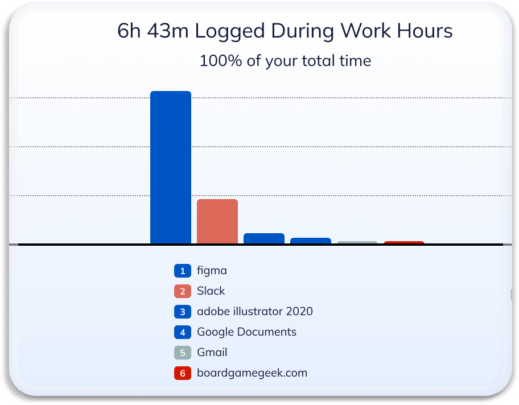
Example of time tracking with RescueTime
Return on investment and impact on corporate culture
AI combined with software can actively encourage employees to adopt practices to improve their level of well-being at work. For example, automated notifications can remind employees to take regular breaks, stay hydrated, or participate in sports sessions. These small incentives help maintain a healthy, dynamic working environment.
Companies can create a more responsive environment focused on the employee experience, promoting overall wellbeing and a better quality of working life, and therefore greater productivity.
Application 6: Automating administrative tasks
HR process automation
AI can automate repetitive administrative tasks such as timesheet management, payroll and benefits. Systems with integrated AI, such as
Silae
or
Payfit
for example, can automate the collection, tracking and calculation of employee working hours. AI-based timesheet management tools can automatically detect anomalies, reduce manual entry errors and ensure regulatory compliance. What’s more, AI can automate payroll processes, including the calculation of wages, tax deductions and benefits, ensuring accurate and timely payments.
HR chatbots like
Dydu
They can answer employees’ questions, book time off and provide information on company policies. These systems can process requests, check available leave balances, and automatically update schedules. They can also inform managers of planned absences and ensure that shifts are properly planned.
AI can also automate administrative document management, including file creation, storage and retrieval. AI systems can automatically classify documents, extract relevant information, and make it easier to find, reducing the time and effort needed to manage documentation.
Finally, AI tools can monitor compliance with regulations and internal policies by analyzing data and generating compliance reports. They can also alert HR managers to any non-compliance, enabling rapid corrective action.
Time and efficiency savings for HR teams
By automating these administrative tasks, AI enables HR teams to become more efficient, reduce errors, and spend more time on strategic initiatives, such as talent development and improving corporate culture.
Application 7: Predictive and Decision Analysis
Using AI for advanced analysis and forecasting
AI can be harnessed to support HR decision-making in recruitment, career management and risk management.
AI algorithms can analyze labor market trends, company growth rates, and turnover histories to predict future staffing needs. By anticipating skills shortages and recruitment needs, HR teams can plan more effectively and launch proactive recruitment campaigns.
AI tools can also evaluate employee performance data, identify trends and predict departure risks. For example, by analyzing performance histories, feedback and employee satisfaction data, AI can identify those at risk of resignation and recommend preventive actions, such as pay rises or development opportunities.
AI can analyze employees’ skills, experience and aspirations to recommend optimal career paths. Using predictive models, HR can identify the best candidates for internal promotions, plan customized training programs and align employees’ career goals with the company’s strategic needs.
AI systems can also analyze compliance data, incident histories and security reports to identify potential risks within the enterprise. Predictive analytics can help prevent problems before they occur, by alerting managers to areas requiring special attention.
Influence strategic decision-making and resource optimization
AI enables HR to make informed decisions by providing data-driven insights. Interactive dashboards and AI-powered data visualizations provide an overview of key indicators, making it easy to analyze trends and identify opportunities for improvement.
AI enables HR to move from a reactive to a proactive approach, using predictive and actionable analytics to optimize talent management and improve organizational performance.
Conclusion
Beyond all the applications we’ve seen, AI is transforming the role of HR professionals, encouraging them to become talent strategists rather than mere administrators. In the years to come, HR professionals will no longer be able to do without AI-based tools to perform better. Data analysis and change management skills are thus becoming increasingly important in this field.
Integrating AI into HR therefore requires technical expertise and an in-depth understanding of human dynamics. Calling in a Outsourced HR may be the ideal solution for taking full advantage of the benefits of AI. Outsourced HR managers bring specialized expertise, fresh perspectives, and tailored solutions to meet your company’s unique challenges. They can help deploy AI technologies efficiently and ethically, while ensuring compliance with labor regulations.

